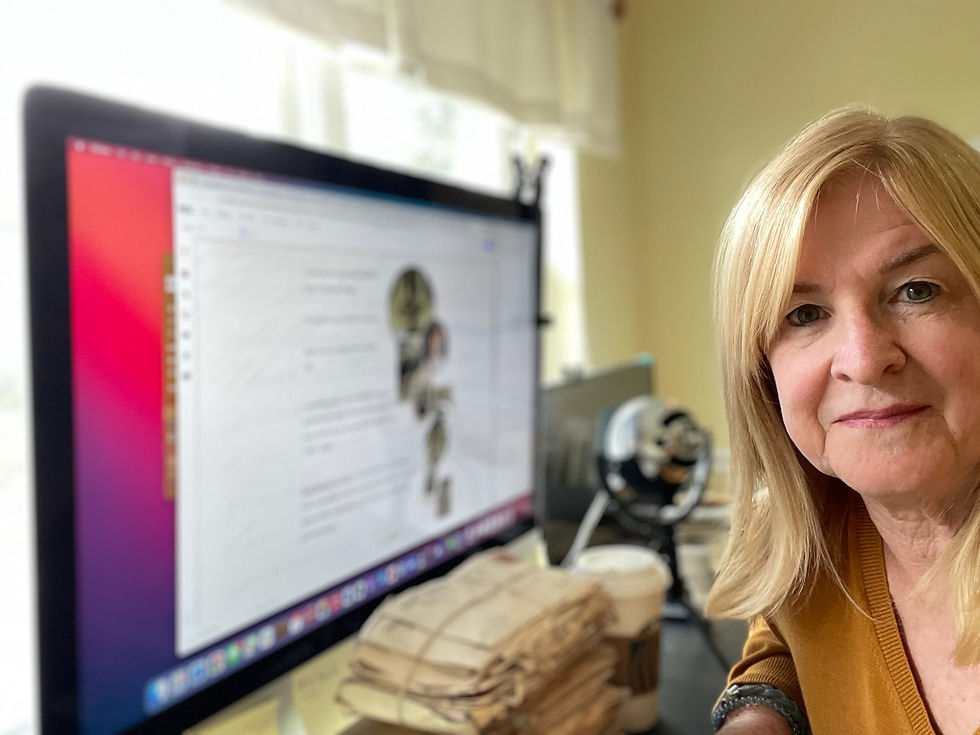Travel to Another Era- One Letter at a Time
- Holly Hazard

- Jun 15, 2022
- 3 min read
Updated: Jun 27, 2022
I never knew my great-grandfather, John Adoniram Briggs. He died two years before I was born. But he was a strong presence in my life. My grandmother, Marion Briggs Dolan, divorced when my mom (Betty Ann) was young. Marion and my mother lived many years in the big, beautiful Victorian home on Main Street in Earlville, New York. I knew my great-grandfather was Vice-President of the Earlville National Bank and president of the school board (he handed both my mom and dad their high school diplomas.) He and my great-grandmother, Susan

Broad Briggs, raised three girls and a boy at the turn of the 20th century. I also knew he worked for The Osborne Art Calendar Company. He tacked up huge posters of trains, yellowed and torn by the time I saw them, high on the walls of the gigantic white barn behind the house. "The Osborne Company” was emblazoned at the bottom of each. I now know these were samples of my great grandfather's wares. I didn't realize then how important The Osborne Company was to my family and, especially, my great-grandfather. While visiting my brother, I stumbled upon a trove of letters my great-grandmother saved (she saved everything from rubber bands to wrapping paper.) I discovered hundreds of love (and other) letters from my great-grandfather, written from 1909 to the late 1940s. Most were from 1920 to 1940, when the four Briggs children were off to college (all three girls went to Syracuse University in the early 1920's), and through the years when his children’s own kids, including my mother, reached adulthood.
I’d discovered the world of a travelling salesman. The Osborne Art Calendar Company published calendars, letter openers, and pens for banks and other businesses to give to customers. I wonder how, as a salesman, my great-grandfather John experienced, and survived, the Great Depression. Driving, or riding the train, from Corning to Geneva to Cooperstown to Binghamton, he spent his weeks, months, years, through summer heat and bitter cold, calling on business owners to buy. And every week, sometimes two or three times, he wrote home. He sometimes bemoaned that, that he'd been "skunked", or that he didn't make one sale. I also have many letters between the four siblings, Marion, Frank, Betty and Lou. They squabbled and gossiped and gave advice to each other just as today we might pick up a phone or text. Through this time, my grandmother, Marion, married a dashing, wild, unstable, but very successful, New York Post reporter who had a gun pushed into his gut while investigating a story of Bahamian rum smuggling, conned his way onto a yacht and spent an evening in New York harbor with Gloria Swanson and Joe Kennedy. Kennedy offered him a job writing in Hollywood so he quit reporting and moved West to become a screen writer. My grandmother, Marion, joined him but it didn’t last long. He ended up in a sanitarium. Heart-broken, Marion sailed on a freighter from Santa Monica to Mexico. But not before placing my 6-year-old mother on a cross-country bus, alone, to Syracuse. My great-grandfather proudly posed with the little girl for a photo in

the Syracuse Herald Tribune, when she arrived safely. Another Briggs daughter, my beloved great-aunt Lou, married a charismatic artist, also an alcoholic and closeted gay man, who became art director for the Avon Company in New York. They lived a swanky life on Park Avenue, or close thereto. Another daughter, Betty, died at age 40 leaving Ray Hoadley, a successful reporter for the Wall Street News and Herald Tribune, and two small children behind. My great Uncle Frank attended Dartmouth, became a reporter and moved to Cleveland, his wife’s hometown. Through all this my great-grandfather wrote home about the hotel expenses, disappointing sales, terrible food, his aching feet or back, and when he'd next be home. Join me as I open, for the first time, hundreds of letters home, documenting the life and times of a rural New York middle-class family, through the Great Depression, family loss and World War II. I don't know what we'll find but I can’t wait to get started!
For context, I'm also including some of the headlines, page 1, above the fold, from The New York Times, for each date the letters were sent. One surprising aside is how colloquial the Times was at the turn of the last century. Everything from run away brides to circus animal escapes were the headlines of the day. This alone is likely to cause some reflection and, I hope, a smile or two.
Holly Elisabeth Hazard

Comments